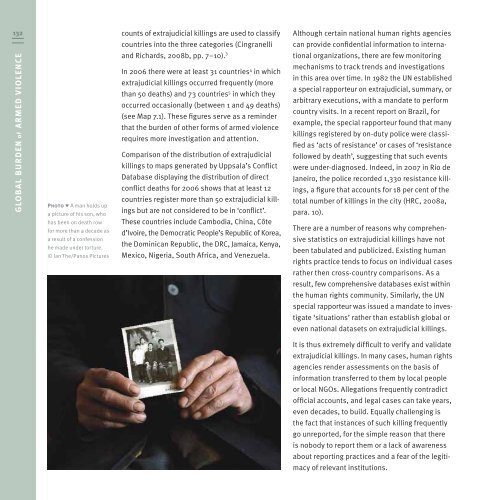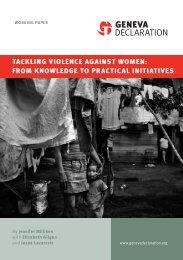Global Burden of Armed Violence - The Geneva Declaration on ...
Global Burden of Armed Violence - The Geneva Declaration on ...
Global Burden of Armed Violence - The Geneva Declaration on ...
You also want an ePaper? Increase the reach of your titles
YUMPU automatically turns print PDFs into web optimized ePapers that Google loves.
132 counts <str<strong>on</strong>g>of</str<strong>on</strong>g> extrajudicial killings are used to classify<br />
GLOBAL BURDEN <str<strong>on</strong>g>of</str<strong>on</strong>g> ARMED VIOLENCE<br />
Photo " A man holds up<br />
a picture <str<strong>on</strong>g>of</str<strong>on</strong>g> his s<strong>on</strong>, who<br />
has been <strong>on</strong> death row<br />
for more than a decade as<br />
a result <str<strong>on</strong>g>of</str<strong>on</strong>g> a c<strong>on</strong>fessi<strong>on</strong><br />
he made under torture.<br />
© Ian <str<strong>on</strong>g>The</str<strong>on</strong>g>/Panos Pictures<br />
countries into the three categories (Cingranelli<br />
and Richards, 2008b, pp. 7–10). 3<br />
In 2006 there were at least 31 countries 4 in which<br />
extrajudicial killings occurred frequently (more<br />
than 50 deaths) and 73 countries 5 in which they<br />
occurred occasi<strong>on</strong>ally (between 1 and 49 deaths)<br />
(see Map 7.1). <str<strong>on</strong>g>The</str<strong>on</strong>g>se figures serve as a reminder<br />
that the burden <str<strong>on</strong>g>of</str<strong>on</strong>g> other forms <str<strong>on</strong>g>of</str<strong>on</strong>g> armed violence<br />
requires more investigati<strong>on</strong> and attenti<strong>on</strong>.<br />
Comparis<strong>on</strong> <str<strong>on</strong>g>of</str<strong>on</strong>g> the distributi<strong>on</strong> <str<strong>on</strong>g>of</str<strong>on</strong>g> extrajudicial<br />
killings to maps generated by Uppsala’s C<strong>on</strong>flict<br />
Database displaying the distributi<strong>on</strong> <str<strong>on</strong>g>of</str<strong>on</strong>g> direct<br />
c<strong>on</strong>flict deaths for 2006 shows that at least 12<br />
countries register more than 50 extrajudicial kill-<br />
ings but are not c<strong>on</strong>sidered to be in ‘c<strong>on</strong>flict’.<br />
<str<strong>on</strong>g>The</str<strong>on</strong>g>se countries include Cambodia, China, Côte<br />
d’Ivoire, the Democratic People’s Republic <str<strong>on</strong>g>of</str<strong>on</strong>g> Korea,<br />
the Dominican Republic, the DRC, Jamaica, Kenya,<br />
Mexico, Nigeria, South Africa, and Venezuela.<br />
Although certain nati<strong>on</strong>al human rights agencies<br />
can provide c<strong>on</strong>fidential informati<strong>on</strong> to interna-<br />
ti<strong>on</strong>al organizati<strong>on</strong>s, there are few m<strong>on</strong>itoring<br />
mechanisms to track trends and investigati<strong>on</strong>s<br />
in this area over time. In 1982 the UN established<br />
a special rapporteur <strong>on</strong> extrajudicial, summary, or<br />
arbitrary executi<strong>on</strong>s, with a mandate to perform<br />
country visits. In a recent report <strong>on</strong> Brazil, for<br />
example, the special rapporteur found that many<br />
killings registered by <strong>on</strong>-duty police were classi-<br />
fied as ‘acts <str<strong>on</strong>g>of</str<strong>on</strong>g> resistance’ or cases <str<strong>on</strong>g>of</str<strong>on</strong>g> ‘resistance<br />
followed by death’, suggesting that such events<br />
were under-diagnosed. Indeed, in 2007 in Rio de<br />
Janeiro, the police recorded 1,330 resistance kill-<br />
ings, a figure that accounts for 18 per cent <str<strong>on</strong>g>of</str<strong>on</strong>g> the<br />
total number <str<strong>on</strong>g>of</str<strong>on</strong>g> killings in the city (HRC, 2008a,<br />
para. 10).<br />
<str<strong>on</strong>g>The</str<strong>on</strong>g>re are a number <str<strong>on</strong>g>of</str<strong>on</strong>g> reas<strong>on</strong>s why comprehen-<br />
sive statistics <strong>on</strong> extrajudicial killings have not<br />
been tabulated and publicized. Existing human<br />
rights practice tends to focus <strong>on</strong> individual cases<br />
rather then cross-country comparis<strong>on</strong>s. As a<br />
result, few comprehensive databases exist within<br />
the human rights community. Similarly, the UN<br />
special rapporteur was issued a mandate to inves-<br />
tigate ‘situati<strong>on</strong>s’ rather than establish global or<br />
even nati<strong>on</strong>al datasets <strong>on</strong> extrajudicial killings.<br />
It is thus extremely difficult to verify and validate<br />
extrajudicial killings. In many cases, human rights<br />
agencies render assessments <strong>on</strong> the basis <str<strong>on</strong>g>of</str<strong>on</strong>g><br />
informati<strong>on</strong> transferred to them by local people<br />
or local NGOs. Allegati<strong>on</strong>s frequently c<strong>on</strong>tradict<br />
<str<strong>on</strong>g>of</str<strong>on</strong>g>ficial accounts, and legal cases can take years,<br />
even decades, to build. Equally challenging is<br />
the fact that instances <str<strong>on</strong>g>of</str<strong>on</strong>g> such killing frequently<br />
go unreported, for the simple reas<strong>on</strong> that there<br />
is nobody to report them or a lack <str<strong>on</strong>g>of</str<strong>on</strong>g> awareness<br />
about reporting practices and a fear <str<strong>on</strong>g>of</str<strong>on</strong>g> the legiti-<br />
macy <str<strong>on</strong>g>of</str<strong>on</strong>g> relevant instituti<strong>on</strong>s.









